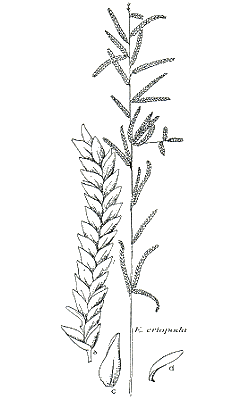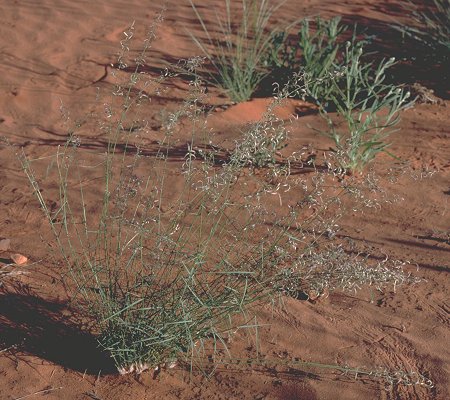Eragrostis eriopoda Benth. Fl.
Austral. 7: 648 (1878).
Classification. (GPWG 2001) : Subfamily
Chloridoideae. Cynodonteae.
Type of Basionym or
Protologue Information: ST: A. Cunningham s.n., Australia: N. Australia: Cygnet Bay,
N. W. coast
ST: Walcot s.n.,
Dampier's Archipelago.
Key references
(books and floras): [1878] G.Bentham, Flora Australiensis 7 (648), [1952]
C.A.Gardner, Flora of Western Australia 1 Gramineae (122), [1981]
M.Lazarides in J.Jessop (ed)., Flora of Central Australia (457), [2002]
D.Sharp & B.K.Simon, AusGrass, Grasses of Australia, [2006]
J.Jessop, G.R.M.Dashorst, F.M.James, Grasses of South Australia (370),
[2008] S.W.L.Jacobs, R.D.B.Walley & D.J.B.Wheeler, Grasses of New South
Wales (251).
Illustrations:
[2006] J.Jessop, G.R.M.Dashorst, F.M.James, Grasses of South Australia (370, fig. 299), [2008] S.W.L.Jacobs,
R.D.B.Whalley & D.J.B.Wheeler, Grasses of New South Wales, 4th edn
(251).
Habit.
Perennial. Culms erect, 22–60 cm tall, wiry. Lateral branches simple. Ligule a
fringe of hairs, 0.6–0.7 mm long. Leaf-blades spreading, straight, involute or
convolute, 1 cm long, 2–3 mm wide.
Inflorescence.
Inflorescence compound, a panicle. Panicle linear or lanceolate or ovate, 9–20
cm long, 3–7.5 cm wide.
Spikelets.
Spikelets sessile or pedicelled. Fertile spikelets many flowered, with at least
2 fertile florets (8–62), comprising 8–62 fertile floret(s), with diminished
florets at the apex, linear or oblong, laterally compressed, 5–30 mm long.
Glumes. Glumes
similar. Lower glume ovate, membranous, keeled, 1-keeled, 3 -nerved. Upper
glume ovate, 1.75–2 mm long, membranous, keeled, 1-keeled, 3 -nerved. Upper
glume surface asperulous.
Florets.
Fertile lemma 2–3 mm long, keeled, 3 -nerved. Lemma apex muticous or mucronate.
Lodicules present. Anthers 2–3. Grain 0.75 mm long.
Continental
Distribution: Australasia.
Australian
Distribution: Western Australia, Northern Territory, South Australia,
Queensland, New South Wales.
Western Australia: Dampier. Mueller,
Canning, Carnegie, Giles, Helms, Fortescue, Ashburton, Carnarvon. Eucla. Northern Territory: Victoria
River, Barkly Tableland, Central
Australia North, Central Australia South. South
Australia: North-western, Lake Eyre, Nullabor, Gairdner-Torrens Basin,
Flinders Ranges, Eastern, Eyre Peninsula. Queensland: Burke, Gregory North,
Maranoa, Mitchell, Warrego, Gregory South. New South Wales:
North-Western Plains, North Far Western Plains, South Far Western Plains.
Notes.
Distinguishing characters include 1–3-nerved glumes; stipiate caryopsis;
bulbous woolly rootbase; closely imbricate florets usually falling entire; leaf
sheaths short relative to internodes, tight on culms, abruptly wider than
blades, with ciliate margins; pouched paleas.
Endemic;
widespread across the centre of Australia from Port Hedland in W.A. to
Charleville in Qld. Commonly in deep, red sands and sandy loams on sandplains,
watercourse levees, dunes and swales; also in shallow often stony or gravelly
sands or loams on sandstone, limestone and quartzite hills and ridges, in
lateritic soils and in heavy-textured red earths and clay loams.; flowers all
year round; fruits all year round.





